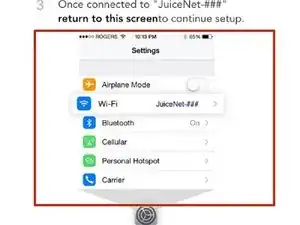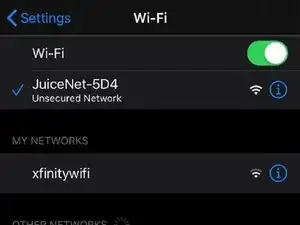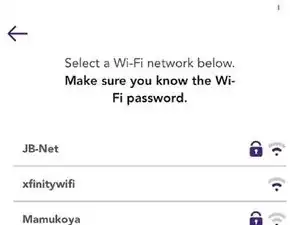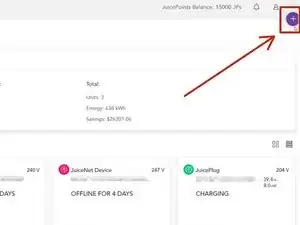Einleitung
-
-
The JuiceBox doesn't talk directly to your phone, or anything local. It talks only to JuiceNet - the cloud server that crunches all the data.
-
The box remembers one WiFi network, and only one WiFi network. It will constantly try connecting to this last-known network as long as it's powered up, retrying every few seconds, for all eternity until the heat death of the universe.
-
The WiFi processor is independent of the safety/J1772 processor. That is to say, it'll charge without WiFi, and the only thing WiFi can do to affect charging is change settings - like a schedule or access control.
-
There are no settings or history stored on the box (technically, history IS stored on the box, but the server/app-side UX is god-awful and doesn't retrieve or process the locally-stored event and energy data). So, everything about the box is done remotely - user control, what car it is, time-of-use, cost, etc., is all cloud-based.
-
The only persistent settings stored in the box are three: WiFi name, WiFi password, and the "offline amperage" - known in the web interface as "Wire Rating". The offline amperage is used when the box first starts, until the box gets a run-time charging rate command from JuiceNet. Anything below 6 amps is "stop charging".
-
You cannot connect JuiceBox to a network that requires web-based login. Networks like "xfinitywifi" won't work because they need a web browser to open to sign-in, and the JuiceBox isn't a web browser. If you can add its MAC address (10.10.10.1/command/get wlan.mac - see PC setup instructions) to your whitelist, it may work.
-
-
-
Modern JuiceBoxes (late 2018 to present) - running ZAP (Zentri Application) firmware - can automatically update their WiFi processor (but not the core/safety processor) when new firmware is available. You know you have a ZAP box if your Setup network has no password ("JuiceNet-###").
-
Older JuiceBoxes (late 2015-late 2018) run the basic ZentriOS core firmware, with no application - acting as "dumb modems" to stream real-time data to the cloud UDP server. These boxes have a Setup mode network with the password "GoElectric" - as written in the manual. Many of these can be updated to ZAP - but read on to why you might not want to.
-
The web setup application was removed from ZAP-based firmware for unknown reasons around mid-2020. This makes it near impossible to set up WiFi outside the EV JuiceNet app, or to save correct settings when the app is incorrectly saying they're not valid, or to connect to a hidden network. It's hard to say if updating is a good thing anymore.
-
Even older JuiceBoxes (2014-2015) have the basic ZentriOS core firmware, but run on older AMW006 modules - in JuiceBox v8.12 and older. These can't be upgraded, and many are stuck with the version they have - though they can be updated to point to a new server, the core processor may not be speaking a modern protocol language.
-
Finally, the very first Kickstarter-era (2013-2014) JuiceBoxes have a Roving Networks WiFly module inside. These can be updated all the way to talk to the modern JuiceNet, but ... it takes wizard skill. Wizard training may come in the later pages of these guides!
-
-
-
JuiceBox gives you setup access within the first 2 to 5 minutes after powering it up. The network name will be either "JuiceBox-###" or "JuiceNet-###" (3 random ID digits).
-
Get a computer or phone ready first. In the EV JuiceNet app, tap the "+" icon in the device list (swipe the right-side menu open and tap "My JuiceNet devices" to get to the list to press the +), then press the "connect device to wifi" big button, then skip to the step that says to plug in your box.
-
Unplug the JuiceBox from power, wait 5 seconds (or the LEDs to go out), then plug it back in.
-
Wait 30 seconds. Newer boxes have an extremely long startup delay due to a timing bug that makes it spam "$$$" to the WiFi processor to get to command mode (it no longer uses command mode, so it times out), before finally starting WiFi setup. Older boxes do it immediately.
-
Finally, tap next in the app, or on PC, connect to the "JuiceNet-###" WiFi network (with GoElectric password, if needed). On iOS, tap the graphic at the bottom to open your phone settings, then go back to the main settings page and tap WiFi, and connect to the JuiceNet network.
-
Back in the app, it should say "Success! Your JuiceNet device (sic) is connected to JuiceNet-###". It should then show you a list of the WiFi networks that are visible to the JuiceBox. On PC, skip down a few steps for manual instructions.
-
Tap your WiFi network name, and enter the password. Then confirm and proceed to verification.
-
About half the time, it will improperly fail to verify the password and tell you the password is wrong. Usually, this isn't correct. Just try it again with the same password (frustrating bug, I know). It should confirm, and if it proceeds past this page, that network is stored in the box and it's just a matter of waiting.
-
-
-
On PC, once you connect to the JuiceNet-### network, try going to http://setup.com or http://10.10.10.1. you might get a browser popup that says "Page not found" due to the web setup app being removed. However, if you get a Zentri connection page, just go ahead and set it up that way and ignore the rest of this.
-
If you get the "page not found" page, just go to the following URLs, in order. Unlike most normal URLs, here, you DO include the spaces and quotes in the URL (the browser should translate them to URL encoding). Also be warned that a hash (#) or percent (%) in your PW needs to be manually encoded (as %23 for a hash #, or %25 for a percent %)
-
http://10.10.10.1/command/set wl s "Your Network Name"
-
http://10.10.10.1/command/set wl p "Your Password"
-
-
-
You're done, and the network is manually stored in the box now. It will constantly try connecting to this network from this moment on. Proceed to setting up JuiceNet!
-
You can technically do these manual setup steps on a mobile device as well, but mobile devices tend to be "smarter than you" and iOS in particular is EXTREMELY difficult to get to cooperate - it doesn't automatically convert spaces in the URL, and won't enable WiFi if it doesn't have internet (as in setup mode), so a laptop is highly recommended.
-
-
-
Once you've got it set up, the app should add the box to your account automatically, if it has no other users. If it has other users, it'll ask for a "pairing pin" which can be found from another user with access on their http://home.juice.net main page (look for the "users" icon/button that says "Guest Sharing Pin").
-
On web/PC, go to http://home.juice.net and log in. On the main screen, click the purple "+" button in the upper-right of the screen, then click "New JuiceNet Device". It should show your unit in the list of detected devices, so you click it there and it'll fill into the field. Then, click the "Add" button below, and you're done!
-
If it gives an error that it's already owned by someone else, you need the app to reset its ownership (it's not implemented in the web version). Add it in the app and at the screen asking for the PIN, tap "Reset Ownership" and follow the steps. At the end, after completing the plug/unplug cycle, it may hang. Simply exit and re-add it, it'll work.
-
To reassemble your device, follow these instructions in reverse order.
5 Kommentare
SUPER helpful -- thanks, I was wondering why the web app turned into "page not found" after I upgraded the JuiceBox to the latest firmware.
Is there anything I can do if I forget the PIN?
@paulwarnicke - PIN shouldn't be something you "can forget" - it's not necessary for the owner of the box to know the PIN. The PIN is supposed to be something you would use if you're sharing the box with someone.
A request for PIN comes up when the box is "owned" by someone else, though. If you're the owner and you're being asked for a PIN, there should be a "reset ownership" button on the old app that you can use to regain access to the box you rightly own.
However, in the absolutely botched roll-out of the "new" platform, "Enel X Way", they've managed to both bungle the ownership of boxes (they end up pre-allocated to assumed email accounts of the old users), and failed to implement any form of ownership reset (a critical feature the old platform had since the beginning). So, if their assumption of ownership was wrong, you're just screwed, no path to reset without contacting support.
The PIN is not part of the box itself - it's solely limited to the gears and machinations of Enel's servers. The fix is entirely within their control.





